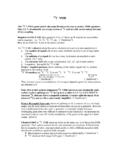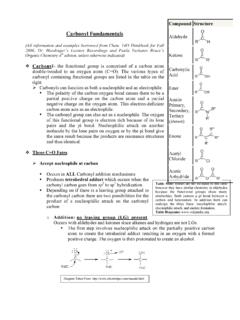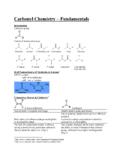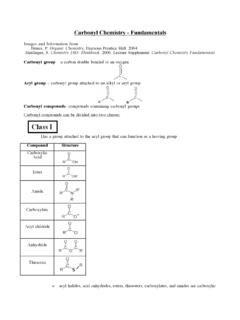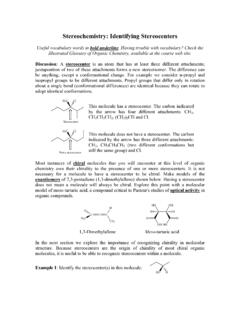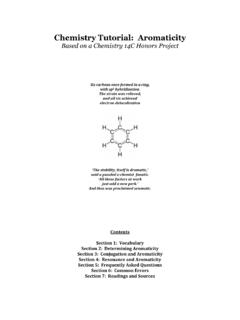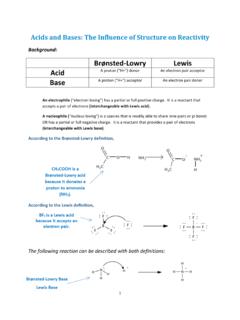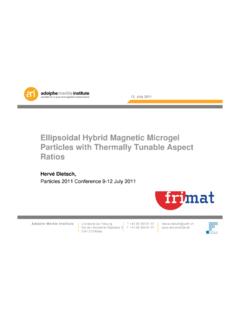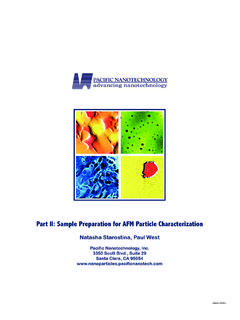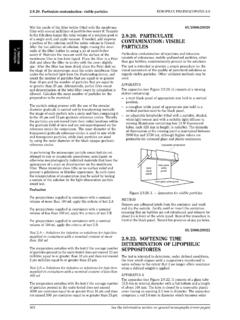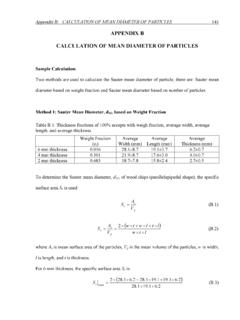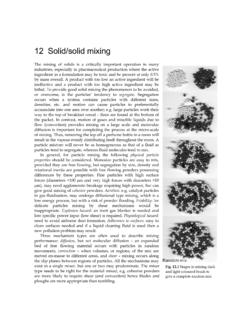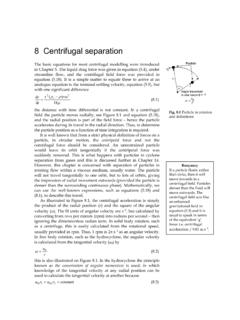Transcription of PROTEIN ADSORPTION ON POLYMER PARTICLES P
1 PROTEIN ADSORPTION ON POLYMER PARTICLES . P. Jung-Hyun Kim Yonsei University, Sudaemoon-ku, Seoul, Republic of Korea Jeong-Yeol Yoon University of California, Los Angeles, California, INTRODUCTION bent are also common terms for ADSORPTION . In the PROTEIN ADSORPTION on POLYMER PARTICLES , adsorbate is PROTEIN and PROTEIN ADSORPTION on POLYMER PARTICLES has significant adsorbent is POLYMER PARTICLES . importance in biomedical applications, both in vitro and PROTEIN ADSORPTION can occur either in vitro or in vivo, in vivo. It has, therefore, been studied from all viewpoints depending on its application. In vivo PROTEIN ADSORPTION for the last two decades, but the results were inconsistent takes place in implants and therapeutic carriers, whereas due to its complexity. It is not an exaggeration to say that membranes generally have in vitro PROTEIN ADSORPTION , nobody knows what exactly happens at the interfaces except for artificial kidneys containing POLYMER mem- between proteins and PARTICLES .
2 Proteins are so large that branes (6). POLYMER PARTICLES have both in vitro and in they cannot be treated as small solutes, and the surface of vivo PROTEIN ADSORPTION . PROTEIN ADSORPTION can also be POLYMER PARTICLES is somewhat hairy, which makes quanti- classified depending on the type of surface whether it is fication difficult. Furthermore, PARTICLES are continuously flat and fixed or particulate and moving. Excluding a few moving, which makes time-dependent in situ measure- exceptions, implants and membranes have flat and fixed ment impossible. surfaces and POLYMER PARTICLES and therapeutic carriers PROTEIN ADSORPTION on flat and fixed surfaces is re- have particulate and moving surfaces. Because we are latively easy to analyze; hence, many techniques have dealing here with PROTEIN ADSORPTION on POLYMER par- been introduced and tested. Although the whole adsorp- ticles,'' PROTEIN ADSORPTION on flat and fixed surface will tion mechanism is not yet completely analyzed, what is not be covered here.
3 However, these two different types known can give some clues about PROTEIN ADSORPTION on of adsorbents will be compared. POLYMER PARTICLES . Biomedical applications of PROTEIN ADSORPTION on poly- In Vitro and In Vivo mer PARTICLES include the following: artificial tissues and In vitro PROTEIN ADSORPTION on POLYMER PARTICLES includes: organs, drug delivery systems, biosensors, solid-phase im- 1) batchwise and chromatographic PROTEIN separation and/. munoassays, immunomagnetic cell separations, and im- or purification with POLYMER PARTICLES ; 2) solid-phase (or mobilized enzymes (1 5). latex-based) immunoassay, especially latex agglutination testing; and 3) enzyme immobilization on POLYMER parti- FUNDAMENTALS cles (1 5). In vivo PROTEIN ADSORPTION on POLYMER PARTICLES takes place in: 1) POLYMER PARTICLES as bearing or filler Definition of Terms implants, especially for artificial cartilage and synovial PROTEIN ADSORPTION can be defined as ADSORPTION (that fluid; 2) magnetized POLYMER carriers for tumor cell sepa- is, adhesion or sticking) of PROTEIN (s) on a variety of sur- ration; 3) hemoperfusion carriers for blood purification.
4 Faces.'' Proteins are generally serum proteins, enzymes, and 4) therapeutic carriers for controlled release and tar- antibodies, and foreign antigens, but genes (that is, pol- geting (1 4). ynucleotides) are sometimes included in this category, In applications in vitro, PARTICLES are generally copoly- although they are not proteins in fact. Surfaces are merized (to get core shell structure) or their surfaces are generally artificially implanted biomaterials (or simply modified chemically and/or biologically. Most common implants), drug and gene carriers (or therapeutic carriers), biological modification can be done by either enzymes or POLYMER PARTICLES , and membranes. Adsorbate and adsor- monoclonal antibodies. Because the properties of envir- Encyclopedia of Surface and Colloid Science 4373. Copyright D 2002 by Marcel Dekker, Inc. All rights reserved. 4374 PROTEIN ADSORPTION on POLYMER PARTICLES fixed nature, PROTEIN ADSORPTION is slower and their equi- librium is less dynamic than ADSORPTION on particulate and moving surfaces.
5 This slowness is preferably helpful for analyzing the phenomenon and makes static analysis pos- sible. Lots of experimental methods are currently available for the flat and fixed surface: SPR (surface plasmon reso- nance, powerful for kinetics study) (7), in situ ellipsometry (measures the adsorbed layer thickness) (8), QCM (quartz crystal microbalance, powerful in quantifying extremely small amounts of ADSORPTION ) (9), TIRF (total internal ref- lection fluorescence spectroscopy, powerful in determin- ing conformational change in adsorbed proteins) (10), and ATR-FTIR (attenuated total reflectance Fourier Fig. 1 Schematic illustration of the PROTEIN ADSORPTION in vivo. transform infrared spectroscopy, powerful in analyzing sequential and competitive ADSORPTION ) (11). These expe- rimental techniques produce data on kinetics, conforma- tional change, and competition behavior, as well as on the onmental media are relatively moderate (that is, New- amount adsorbed. tonian behavior, low ionic strength, and moderate pH) for However, none of these techniques are of any use in this type of application, the key factor is only PROTEIN studying PROTEIN ADSORPTION on POLYMER PARTICLES , where itself.
6 ADSORPTION equilibrium is faster and more dynamic and However, in vivo applications are much more compli- adsorbents ( POLYMER PARTICLES ) are continuously moving. cated than in vitro. Besides PROTEIN , blood and lymphatic Therefore, we must rely on the rather primitive method of vessels are also involved, which makes the entire phe- separating aqueous phase from POLYMER PARTICLES and nomenon much more complicated. Blood clotting triggered quantifying residual PROTEIN content. This gives us suf- by fibrinogen causes another significant problem. The size ficiently reliable and reproducible data, but kinetic and of cells (normally larger than POLYMER PARTICLES ) also makes conformational information cannot be obtained in this the phenomenon difficult to analyze. Some cells, such as way. Advanced methods have therefore been developed, macrophages, even attack the PARTICLES , recognizing them such as in situ monitoring of the adsorbed proteins with as foreign enemies. Lots of preexisting proteins compete fluorescent labeling (radiolabeling can also be used, but with each other, which causes the so-called Vroman effect.)
7 Is not so common today) (12), kinetic study with a flow Besides, medium properties are different from those in the cell (13), and adsorbed layer study with DLS (dynamic conditions in vitro non-Newtonian behavior and high light scattering) (14). We will discuss details of these in a ionic strength. The most complicated part in the application later section. in vivo is that the surface itself is continuously moving, either by forced blood flow or by intrinsic Brownian Biological Importance motion. Fig. 1 illustrates the PROTEIN ADSORPTION in vivo, including cell and tissue responses. In vitro applications of PROTEIN ADSORPTION on POLYMER PARTICLES include PROTEIN separation, solid-phase immuno- assay, and enzyme immobilization (1 5). Ligand coupling Flat and Fixed Surface vs. Particulate and to POLYMER PARTICLES is required for all of these applica- Moving Surface tions, where the ligands have strong affinity for specific As mentioned earlier, PROTEIN ADSORPTION can be classified biomolecules.
8 Monoclonal antibodies, PROTEIN A, affinity into two categories depending on the nature of the sur- dyes, and enzymes are the most common ligands used. face flat and fixed surface, and particulate and moving These ligands are generally coupled by covalent bonding;. surface. PROTEIN ADSORPTION on flat and fixed surfaces can hence, PROTEIN ADSORPTION is not so important for ligand be observed in implants and membranes. Common im- coupling itself. However, nonspecific ADSORPTION causes plants include orthopedic implants (bone, cartilage, liga- lots of problems, because proteins adsorb on almost all ment, and tendon), dental implants and coatings, artificial surfaces. One might assert that the saturation by ligands blood and lymphatic vessels, hard tissue implants (a heart could solve this problem, but this saturation causes the so- valve, for example), and soft tissue implants (breast im- called prozone phenomenon, which lowers the efficiency plants being the most common example).
9 Both metals and of affinity ligands (5, 15). (The general scheme of optimal polymers can be used as implants. Due to their flat and ligand coupling is shown in Fig. 2.) Therefore, we need a PROTEIN ADSORPTION on POLYMER PARTICLES 4375. is a famous example for 1:1 matching of adsorbate and active site: G KC. P. one -parametered K . Gm 1 KC. G is the adsorbed amount per unit surface area, Gm is its maximum value (full coverage of surface, or saturated ADSORPTION ), and C is the concentration of PROTEIN . K is the ADSORPTION -to-desorption ratio, or equilibrium constant for the ADSORPTION process. The shapes of experimental isotherms are pretty similar to the Langmuir isotherm, so researchers used this equation to determine the saturated ADSORPTION and kinetic constant. However, the validity of the Langmuir isotherm has been questioned for a long time, because it is so unrealistic that one PROTEIN molecule attaches to only one active site. We proposed to use the Langmuir-Freunlich isotherm for pro- tein ADSORPTION , where the second parameter (n) was fixed as a constant that depends on the type of PROTEIN (1, 16 18).
10 G KC 1=n two -parametered K and n . Gm 1 KC 1=n Fig. 2 Optimal ligand coupling prevents prozone phenomenon. Although there are several mathematical models for the ADSORPTION isotherm of proteins, the universal one-para- precise control mechanism to prevent this nonspecific ad- metered isotherm is not yet established. Considering the sorption. That is the main motivation for studying PROTEIN different characteristics of each PROTEIN , the two-parame- ADSORPTION on POLYMER PARTICLES , because the exact mech- tered isotherm makes more sense than the one-parame- anism of PROTEIN ADSORPTION has not yet been established. tered. Note that K depends on both PROTEIN and surface, If the exact ADSORPTION mechanism were known, then hy- drogen and ionic bonding (or even hydrophobic interac- tion) could be used for ligand coupling, which is expected to reduce dramatically the time and effort required for complicated covalent coupling. PROTEIN ADSORPTION on POLYMER PARTICLES is much more important in the applications in vivo bearing or filler biomaterials and various therapeutic carriers.

